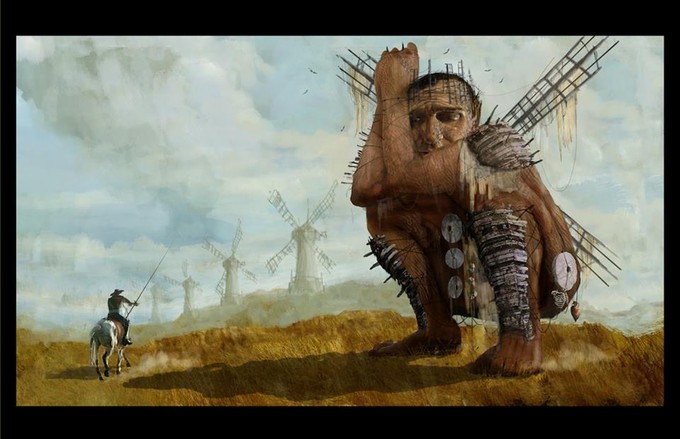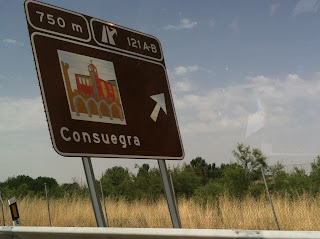Don Quijote, now accompanied by Sancho Panza, tilts at windmills at the start of his second sally.
The interesting part of the reputation of Don Quijote and the fame won by this novel is that it is always, always, always, the windmills that people know. When asked to define what the word quixotic means or the phrase "titlting at windmills," they would be able to do so even without having read a single word in the novel or to recall anything else from it.
 |
| A 17th century Spanish windmill |
 |
| Tour bus on the left shows just how popular this site is, you can see the windmills and the castle in the center, and on the right is the town of Consuegra |
So, let me summarize the scene since it is so crucial to the novel. Don Quijote convinces his neighbor Sancho Panza (Sancho the Belly) to come with him on adventures. He lures his loyal but uneducated friend into these adventures with the promise of an island of which Sancho will be the governor. Sancho not only believes Don Quijote but believes him so much that he is worried his peasant wife will not be suited to rule over an island with him. He frets over the details of this new title and responsibility as they leave the village, and it is easy to feel sorry for the simpleminded but optimistic Sancho.
 |
| You can tour inside some of the windmills and some are now little stores like this one |
The two friends do not travel too far when Don Quijote spots the windmills in the background. Keep in mind that windmills were really important at this time for grinding grains, oats, etc. There was no electricity or other way to run a mill, except by wind or water. Since La Mancha means arid land, there was only wind to run the mills to grind corn or grains to make flour. They also worked as wells to draw up water. Clearly this was important to an agricultural center and dry region, so you can imagine how many windmills covered just about every hilltop. They still do today, but they are the modern ones, turbines, that are storing the energy and using it as electricity. They are the huge white ones in the picture below. *Side note: if you live near Atlanta and want to see an old mill on a river, go to Sweet Water Creek because it is also the site where they filmed a scene in the Hunger Games!*
 |
| View of the old ones- what Don Quijote would have seen (minus the telephone pole) |
 |
| Actual view today of what you see driving through La Mancha |
Don Quijote sees these windmills and cries out that they have found 30 or 40 giants and that in this battle with them, he will destroy an evil breed and win great riches. Sancho asks what giants. Don Quijote points to the windmills. Sancho identifies them as windmills and says as much. Don Quijote tells Sancho that he is not versed enough in tales of adventures to see the truth and that Don Quijote will just have to show him that these are giants. He spurs his horse and charges while Sancho yells that he is attacking windmills, not giants. Don Quijote shouts brave challenges at the windmills and when the wind moves the arms, he sees it as a sure sign of the giants threatening him. He continues shouting, this time to his lady Dulcinea de Toboso, and charges.
The lance gets caught in the sail, breaks, and picks Don Quijote and his horse up a few feet off the ground before they drop back down, painfully. Sancho rushes to him, and Don Quijote is convinced that the evil sorcerer Freston the Wise enchanted the giants and turned them into windmills to embarrass him.
Then, they leave for Puerto Lapice, which I have already mentioned in the last post. Now that the background is clear, it is easy to see why a city with some windmills that have been preserved or recreated is such a popular destination for tourists. This hill also has a stunning view of La Mancha from the top. It was the first place we stopped on our trip, and it makes a great first impression.
 When you get to the town, it is easy to follow signs to the windmills at the top of the hill. Once up there, the first windmill is the tourist information center. The people there are really nice and happy to tell you everything you could possible want to know about windmills, Don Quiojote, and the area around them. It should be the first stop, and you should grab some maps and brochures. You can also get a passport of Don Quijote, similar to what the national park service does, that can be stamped at all of the major sites in La Mancha.
When you get to the town, it is easy to follow signs to the windmills at the top of the hill. Once up there, the first windmill is the tourist information center. The people there are really nice and happy to tell you everything you could possible want to know about windmills, Don Quiojote, and the area around them. It should be the first stop, and you should grab some maps and brochures. You can also get a passport of Don Quijote, similar to what the national park service does, that can be stamped at all of the major sites in La Mancha.There are a few more old buildings and interesting things in the city center of Consuegra and the tourist office can recommend a good place to eat. However, it was so hot and we wanted to get to Baeza for dinner, so we didn't stay very long.
I know it's Wikipedia, but the page does a fairly good job of explaining and offering modern references to Tilting at Windmills!
 |
 |
 |












No comments:
Post a Comment